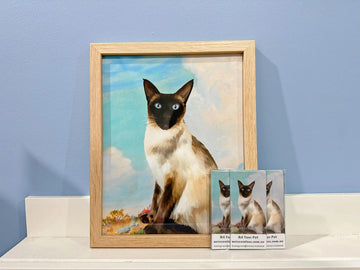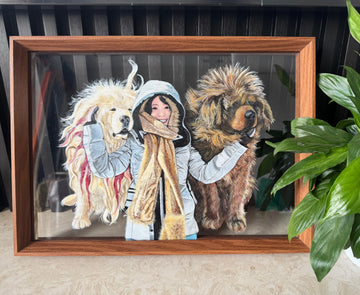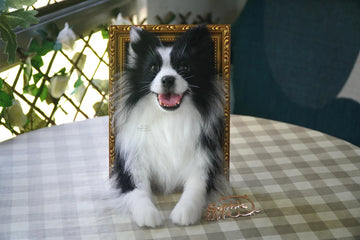Choosing a pet oil portrait is part art decision, part interior design choice, and part love letter to your companion. The right style does more than “look like” your pet—it tells a story that feels at home on your wall. This guide will help you compare popular styles, understand how each reads in a space, and select a format that complements your décor, your pet’s personality, and the way you want to remember them.
1. Why Style Matters More Than You Think
Style is not a surface decision—it affects how a portrait feels, how it changes with the light, and how it speaks to your home. The same reference photo can become cozy, elegant, bold, or ethereal depending on technique and medium. When you choose a style, you choose a voice for the memory.
2. A Quick Tour of Popular Styles
- Realism: Crisp detail, faithful likeness.
- Impressionism: Loose brushwork, light & atmosphere.
- Abstract/Contemporary: Shapes, color fields, graphic energy.
- Monochrome/Tonal: Understated, architectural, design-forward.
- Classic/Old-Masters Inspired: Historic palettes, chiaroscuro drama.
- 3D Glass Oil Portraits: Layered depth with luminous presence.
- Hybrid: Personalized blend across styles and mediums.
3. Realistic Portraits
Best for: Families who want an accurate, expressive likeness that “feels like” the pet at first glance. What you’ll see: Fine fur texture, clear eyes with reflected light, true-to-life coloration, nuanced muzzle and whiskers.
Realism excels when tiny cues matter—like the slight asymmetry of ears, the flecks in the iris, or the particular curl of a tail. In contemporary homes, a realistic piece can read as a refined focal point; in traditional spaces, it behaves like a classic portrait.

4. Impressionistic Portraits
Best for: Light-filled rooms and families who prefer mood over micro-detail. What you’ll see: Visible brushstrokes, soft edges, color harmonies that evoke time-of-day or season.
Impressionism is forgiving and poetic. It’s ideal if your favorite memory involves motion—running on the beach, chasing sunbeams, or dozing in afternoon light. The piece changes subtly with different lamps and daylight, keeping the portrait “alive.”

5. Abstract & Contemporary Styles
Best for: Modern interiors, bold color palettes, or a more symbolic approach. What you’ll see: Emphasis on shape, geometry, negative space, or color blocks; the likeness may be stylized or partial.
Abstract portraits can convey personality without literal detail—think a sleek silhouette, a kinetic color field suggesting playfulness, or gestural marks for a high-energy pup. They read as art first, portrait second, which many design-forward homes love.

6. Monochrome, Tonal & Minimal
Best for: Minimalist or architectural spaces, gallery walls, and calm bedrooms. What you’ll see: A restrained palette (charcoal, sepia, indigo, umber), strong composition, and elegant quietude.
Monochrome pieces highlight form and gesture. With distractions removed, attention rests on expression and silhouette. These portraits can be a sophisticated bridge between contemporary furniture and sentimental subject matter.

7. Classic & Old-Masters Inspired
Best for: Formal living rooms, libraries, dining rooms, and homes with antique or transitional furniture. What you’ll see: Historic palettes, varnished depth, chiaroscuro lighting, and stately posture.
Old-Masters inspired work gives pets the gravitas typically reserved for human portraiture—an affectionate, slightly theatrical nod that turns companion animals into dignified sitters. Perfect for families who love history and storybook charm.

8. 3D Glass Oil Portraits
Looking for something modern with presence? Layered painting on transparent surfaces creates dimensionality that feels alive. As light passes through and reflects, the portrait gains a subtle shift—meeting you differently at every angle.
Explore the format here: 3d glass pet memorial. For a primer on dimensional pet art and how it compares to traditional canvas, see: 3d pet.

9. Hybrid Approaches & Custom Commissions
Many families ask for “a bit of both”—for instance, realistic eyes with impressionistic fur, or a classical pose rendered with contemporary color. Hybrids let the artist tune the portrait to your story and your space. If you love realism but worry about it feeling too formal, ask for a looser background or softened edges. If you adore abstraction but want recognizability, request a more literal face.
10. Room-by-Room Style Guide
- Entryway: Bold styles (abstract, 3D glass) make a strong first impression; medium-to-large sizes anchor the space.
- Living Room: Realism or impressionism over the sofa reads warm and welcoming; classic styles suit mantel displays.
- Dining Room: Monochrome or classical keeps the room elegant and calm during gatherings.
- Bedroom: Impressionistic or tonal portraits create a restful mood.
- Home Office: Minimal or contemporary styles keep the space focused, with personality.
- Hallway Gallery: Mix formats—small monochromes, one 3D glass piece, and a few studies for rhythm.
11. Size, Framing & Lighting
Sizes: 11×14″ or 12×16″ is versatile; 16×20″+ becomes a focal point. Consider sightlines—if viewing distance exceeds 8 feet, larger sizes maintain impact. For gallery walls, mix 8×10″ studies with a single hero piece.
Framing: Float frames emphasize canvas object-ness; gilded frames elevate classical work; thin black frames sharpen contemporary pieces; natural wood brings warmth to monochrome or impressionism.
Lighting: Indirect daylight is ideal. At night, aim for 2700–3000K warm LEDs with a high CRI to honor color accuracy. Position lights at ~30° to avoid glare—especially important for glass formats.
12. Color Theory for Pet Portraits
- Complementary pop: Golden coats sing against cool blue-green backgrounds; black pets glow with warm umbers.
- Analog harmony: Close neighbors on the color wheel (e.g., blue–teal–green) create soothing, designer-friendly vibes.
- Neutral sophistication: Bone, linen, ivory, stone—excellent with minimal or classical pieces.
- Accent echo: Borrow a hue from textiles/art in the room to “weave” the portrait into the space.
13. Matching Style to Personality
- The Social Butterfly (dogs who live for the party): Impressionism or color-forward contemporary.
- The Old Soul (gentle seniors, contemplative cats): Realism with warm glazing; classical palettes.
- The Comedian (zoomies, mischief): Abstract/contemporary with kinetic marks and bold shapes.
- The Zen Master (calm rabbits, dignified cats): Monochrome, tonal, or soft impressionism.
- The Guardian (confident posture, steady gaze): Old-Masters inspired or realism with strong directional light.
14. Commission Process & Practical Tips
- Clarify the story: What do you want the portrait to say—playful, noble, serene, witty?
- Pick references: Choose photos that show character, not just clarity; include a favorite expression.
- Discuss style: Share rooms photos; talk scale, framing, and color warmth/coolness.
- Review sketch/underpainting: Many artists share progress; give holistic feedback once, not piecemeal tweaks.
- Finalize & place: Plan installation height (center ~57–60″ from floor) and lighting angle.
15. Longevity & Care
Keep portraits out of harsh sun and away from high humidity areas. Dust gently with a clean, soft brush. For glass pieces, microfiber cloths and a light touch prevent streaks. If you notice surface dullness over the years, a professional varnish refresh can revive depth. With basic care, both canvas and glass portraits can become family heirlooms.
16. FAQ
Which style is most “timeless” for long-term décor?
Realism and classic/old-masters palettes age especially well, but tasteful impressionism is also enduring. If your décor evolves often, choose a restrained background and neutral frame for lasting versatility.
Can a portrait combine multiple reference photos (pose, face, background)?
Yes. Many commissions blend the best parts of several images into one cohesive composition. This is common in custom portrait oil painting projects and helps the artist capture the truest sense of character.
How do 3D glass oil portraits differ from canvas?
Canvas offers tactile brushwork and classic warmth; glass adds dimensional layers and luminous depth that shift with viewing angles. If you want a modern statement piece with movement, consider a 3d glass pet memorial. For an overview of dimensional pet art, see 3d pet.
What size should I choose for different rooms?
Over a sofa: 24×30″+ feels balanced; hallways: 11×14″ clusters; bedroom: 12×16″ or 16×20″ for calm presence. If viewing distance is 8–10 feet, go larger so facial expression reads clearly.
Is an abstract style risky if I still want likeness?
Not if you anchor the face more literally and loosen the background/gesture. Hybrid approaches deliver recognizability with contemporary energy—great for modern homes that still want emotional connection.
How should I coordinate frame and room finishes?
Warm woods pair beautifully with impressionism and monochrome; black metal frames sharpen contemporary work; antique gold elevates classic pieces. Match frame sheen (matte/satin) to nearby fixtures for harmony.
17. Closing Thoughts
There’s no single “best” style—only the right pairing of story, space, and sentiment. Realism honors detail; impressionism celebrates light; abstract leans into energy; monochrome whispers with restraint; classic work grants timeless dignity; and 3D glass adds living depth. Hybrids make the portrait unmistakably yours.
If your goal is a modern memorial with luminous presence, explore 3d glass pet memorial. If you’re leaning toward a hand-crafted heirloom on canvas, browse our 3d pet primer and compare with traditional custom portrait oil painting approaches to see which voice fits your home.
Whatever you choose, let the portrait serve the life you shared: a daily reminder of companionship, character, and the joy that still lives on your walls.





